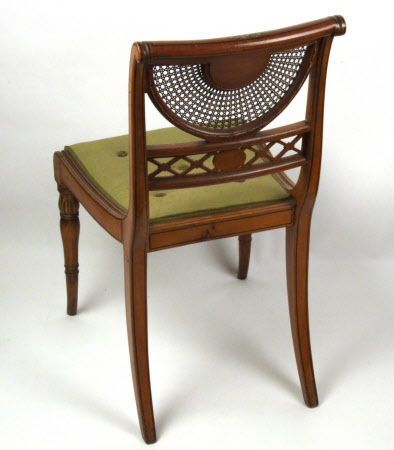Chair
style of Thomas Sheraton (Stockton-on-Tees 1751 – 1806)
Category
Furniture
Date
1790
Materials
paint, satinwood, cane and brocatelle
Measurements
840 x 460 x 515 mm
Order this imageCollection
Fenton House, London
NT 1448775
Summary
A polychrome-decorated satinwood chair, English, circa 1790, the scrolling top rail centred with an oval painted with a boy and girl in grisaille against a green landscape, the oval flanked by painted flowering cornucopia, above a crescent-form cane panel, it's frame painted with a beaded white border, a rectangular panel of open trellis-work painted with blue flower and centred by an oval painted with a cupid playing a bugle, the seat rails painted with a vine motif and paterae, on turned and tapering front legs painted with husks and leaves, the buttoned drop-in seat re-upholstered in green brocatelle.
Provenance
This chair is illustrated in A. E. Reviers-Hopkins, 'Little Books About Old Furniture Vol. IV, The Sheraton Period - Post-Chippendale Designers, 1760-1820', fig. 76. This chair is also mentioned on p.114 - 'The first of the trio (No. 76) is of such exceptional quality, both as to decoration and design, that one would like to label it "made by Sheraton and painted by Angelica Kauffmann." The painted medallion set in the fan-shaped cane-worked panel is the Kauffmann style, and, whatever the name of the designer, it was made by a consummate craftsman. The diamond lattice-work between the two lower rails, the graceful upward sweep of the sides into the back posts and the scrolled top, to say nothing of the fan, all point to Adam design in excelsis.' In the collection of Mr. George Stoner, West Wickham, Kent, Bequeathed by Lady Katherine Binning (1871-1952) with Fenton House in 1952.
Makers and roles
style of Thomas Sheraton (Stockton-on-Tees 1751 – 1806), cabinetmaker style of Thomas Sheraton (Stockton-on-Tees 1751 – 1806), furniture designer
References
Little book about old furniture., A. E. Reviers-Hopkins, 'Little Books About Old Furniture Vol. IV, The Sheraton Period - Post-Chippendale Designers, 1760-1820', fig. 76.

